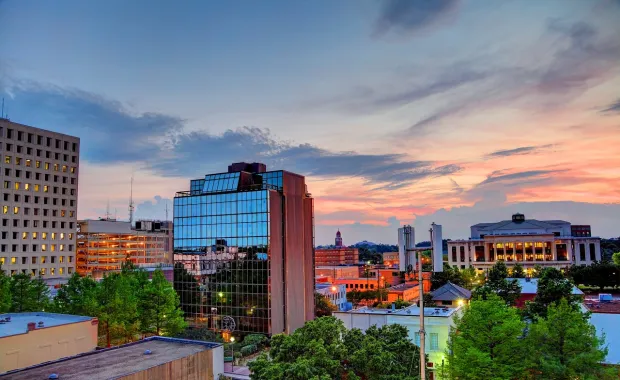Lafayette, Louisiana, is a community with an economy that historically has been driven by the energy sector. In recent years, the City-Parish government (Lafayette Consolidated Government, LCG) has been working to position information technology as one of the new pillars of its economy, creating over 1,000 new technology jobs.
The emerging technology sector in Lafayette is made possible in part by gigabit-fiber-to-the-home infrastructure from municipal-owned Lafayette Utilities System (LUS Fiber), making Lafayette one of the relatively small number of gigabit cities in the country. (On average, U.S. Internet users have connections of 10 megabits per second. One gigabit per second is 100 times faster.)
Another catalyst to digitally transforming Lafayette is smart community initiatives that pair LCG with the University of Louisiana at Lafayette (UL Lafayette), which has one of the country’s top Computer Science and Informatics programs, and CGI, which has a state-of-the-art technology center in Lafayette. This convergence happens through a unique public-private partnership model called the Lafayette Engagement and Research Network (LEaRN) collaborative.
LEaRNing as we go
As a natural progression, Lafayette community leaders are asking: how can we best apply technology to improve the quality of life of our citizens in a sustainable manner?
I think that the LEaRN partnership, with its multi-dimensional focus on smart community themes, is going to help cities of all sizes help find answers to this question.
LEaRN’s focus is on understanding how smart community initiatives can be leveraged successfully to help local governments better manage resources, improve planning, make more informed decisions and improve citizens’ quality of life. This approach combines agile, iterative processes that are allowing us to start small, learn as we go, pivot as needed and scale out when ready. LEaRN feels that this agile or lean startup model for building a smart community approach in Lafayette is going to help build momentum and guide future efforts in the parish.
Near-term, LEaRN is working to deploy 300 low-cost air quality sensors as part of an Environmental Protection Agency (EPA) Smart City Air Challenge. It is also using this project to engage numerous community groups, including STEM education, civic engagement, healthcare and city planning stakeholders. It is amazing to see how this small project is inspiring follow-on initiatives already. LEaRN is in active discussions to apply this same approach to urban flooding and storm-water management challenges faced within the region.
For the EPA challenge, LEaRN formed additional partnerships to help accelerate its progress, including One Acadiana (the regional chamber of commerce), Lafayette Economic Development Authority, Downtown Development Authority, Lafayette Parish School System (LPSS) and South Louisiana Community College (SLCC). These partnerships will be important to achieving objectives related to STEM education and civic engagement.
LEaRN hopes to use the public library to host community outreach events, leverage its Louisiana Department of Environmental Quality advisory board member to help with community outreach, and tap into LPSS to build STEM education initiatives associated with the project. Other advisory organizations for LEaRN include Microsoft, US Ignite, the Center for Neighborhood Technology in Chicago, IL and The Enterprise Center in Chattanooga, TN.
The LEaRN air-quality challenge work began in January with buying sensors that measure Ozone, Particulate Matter 2.5, temperature and humidity. Additional hardware and materials were purchased to design and build a ruggedized sensor platform prototype. This spring, two of these prototypes were deployed, and a second round of prototypes will be deployed this summer. Production roll out of the final design will occur this fall, with the majority of sensor platforms utilizing LUS Fiber for both connectivity and power.
The LEaRN team is using a multi-pronged community engagement strategy to prepare for the larger set of deployments that will occur in rolling waves in the fall and include:
- Students: Middle and high school students engaged in STEM programs across the parish, along with students from UL Lafayette and SLCC, will be invited to learn about the Internet of Things and air quality by building sensors.
- Community: Members of the local community will be invited to participate in outreach sessions held at locations like the public library to discuss the project, understand how the sensors work and learn more about air quality and environmental issues.
- Government, business and technology stakeholders: All data that is collected through LEaRN’s project is open and freely available to public, government, business and technology stakeholders. (Read more about our Kinota™ open source application programming interface.) With one hackathon under its belt to help inspire civic engagement and additional open data initiatives in Lafayette, LEaRN is serving as a catalyst for the launch of more civic engagement, open data and smart community projects.
Opportunities for communities of all sizes
Lafayette is a small to mid-size city, and the LEaRN team thinks this makes it a perfect test bed for smart community efforts. It is also representative of a major challenge that needs to be navigated in the smart community ecosystem, and that is the fact that the financial assets in place and the investment that can be attracted to larger metropolitan areas is on a completely different scale than what a mid-sized or smaller city can achieve. A big challenge for smaller communities is how to take advantage of smart city technology when fewer assets and resources are available and do so in a way that creates a sustainable strategy.
Thinking about this challenge takes me back to a conversation I had recently with a Chief Innovation Officer from a neighboring state capital when I asked her, “What do you think leads to a sustainable strategy for a smart community in your city?” Her answer stuck with me. She said that communities really need to take a step back and understand what assets they have, and then determine how they can address the problems that are most meaningful for the people who live there by leveraging these assets. (I invite you to read more on the importance of “knowing your community” in a blog by my colleague Jeffrey Smith.)
In Lafayette, the community’s assets include: a history of creativity and innovation that led to innovations like US Fiber, a renowned university research institute with UL Lafayette, and a growing, actively engaged information technology sector of the economy with companies like CGI. All of these assets are being combined through LEaRN. In other cities, it will be a different combination that comes together to create a sustainable strategy.
The LEaRN collaborative is happy to share its experience with others who want to catalog and marshal their assets to build a sustainable, smart city program. LEaRN more.





